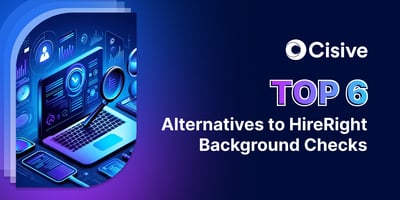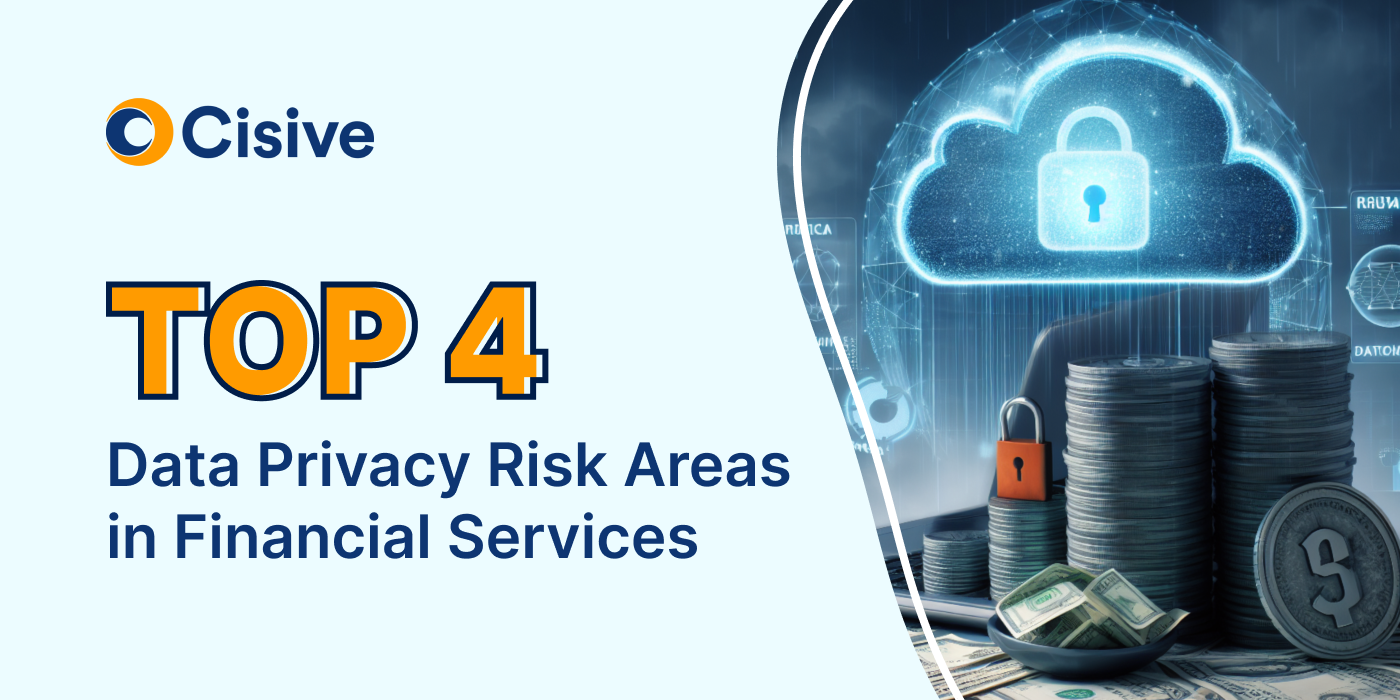
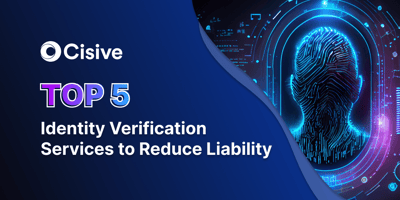
Identity theft is on the rise. So, how do you know you’re making an employment offer based on the...

Financial institutions handle vast amounts of sensitive customer information every day. This makes them targets for cybercriminals seeking to exploit vulnerabilities and compromise data security. To mitigate these risks and protect customer trust, organizations must prioritize comprehensive data privacy training for employees.
Data breaches in financial services are especially costly — 28% more expensive than the global average across industries. Investing in robust data privacy training reduces the risk of data breaches and compliance issues. It also improves your reputation with customers and demonstrates your commitment to data privacy and protection.
Discover why data privacy training for employees in financial services matters — and how to design and implement effective training.
Key Takeaways
|
Protecting data privacy is good for the financial and reputational health of all businesses, and particularly for financial services. Here are four reasons data privacy should be a priority.
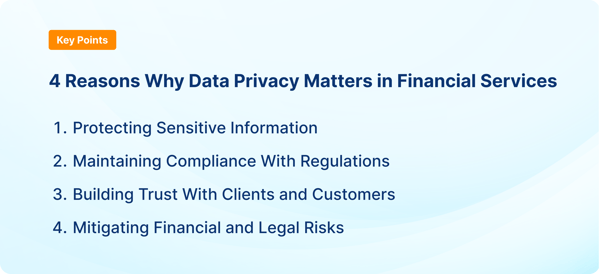
Financial institutions handle a vast amount of personal and financial data. Some of the sensitive data employees in financial services could have access to includes:
Personal identifying information (PII): This includes customer names, addresses, social security numbers, dates of birth, and other information needed to open an account, verify identity, and process transactions.
Providing data privacy safeguards this sensitive information from unauthorized access, identity theft, fraud, and other malicious activities.
Data privacy regulations protect consumers’ personal data from misuse, breaches, or other security incidents. Consumer protections are especially important in financial services, where clients and customers share highly sensitive information. Failure to follow data privacy laws can result in financial penalties and legal consequences.
The most significant data privacy and data protection laws in financial services include:
Noncompliance or privacy incidents can lead to negative publicity, loss of customer trust, and damage to your organization's reputation. Financial institutions that violate data privacy regulations face increased regulatory scrutiny, audits, and investigations.
Data privacy is essential for building trust with clients and customers. When people trust their financial data to a bank, they expect it to be handled securely and confidentially. By prioritizing data privacy, financial institutions burnish their reputation with customers and prospective clients.
Data breaches and privacy violations can have significant financial and legal consequences for financial institutions. The costs associated with investigating and remediating a breach, compensating affected customers, and potential legal actions can be substantial. In 2023, the global average cost of a data breach reached $4.45 million, an increase of 15% since 2020, IBM research shows.
By prioritizing data privacy, you can prevent these risks before they happen or minimize their severity to protect your financial stability.

Data privacy in financial services is an everyday concern, as many employees handle sensitive customer data with regularity. Here are some of the top risk areas where data breaches may occur.
Data handling refers to the process of managing and manipulating data throughout its life cycle. In financial services, data handling involves managing multiple types of sensitive customer information, including personal information, financial transactions, account balances, credit card information, and investment portfolios.
Mishandling customer data, such as leaving sensitive information unattended or sharing it with unauthorized individuals, can lead to unauthorized access and data breaches. Improper handling of data, such as sending sensitive information through unsecured channels or using personal devices, can result in data leakage and compromise customer privacy. Mistakes in data entry, processing, or transmission can lead to inaccuracies, data loss, or inadvertent disclosure of sensitive information.
Data storage is the process of storing and retaining data in a secure and accessible manner. In the context of financial services, data storage involves the secure storage of sensitive customer information, financial records, transactional data, and other relevant information.
Inadequate security measures, such as weak access controls, lack of encryption, or vulnerabilities in systems, can expose customer data to unauthorized access and cyberattacks. Employees with access to sensitive data could intentionally or unintentionally misuse or disclose it, leading to data breaches or privacy incidents. Inadequate physical security measures, such as unauthorized access to data centers or improper disposal of physical documents, can also compromise data security.
Data sharing refers to the process of exchanging or providing access to data between different entities or individuals. Within financial services, data sharing involves sharing sensitive customer information, financial data, or other relevant information — but only with authorized people and for clear, job-related reasons.
Sharing customer data with third-party vendors or partners without proper data sharing agreements or security measures can increase the risk of breaches or unauthorized data use. Once data is shared, financial institutions may have limited control over how it's handled, stored, or protected by the receiving party. This increases the risk of data privacy issues.
Transferring customer data across borders complicates compliance, as you must follow each jurisdiction’s rules and regulations. Inattention in this area increases the risk of noncompliance.
Your incident-response process reacts to and mitigates the impact of a data breach or security incident. The process involves identifying, containing, investigating, and responding to the breach to minimize damage, protect affected individuals, and prevent further unauthorized access or data loss.
Inadequate incident-response planning or lack of awareness can result in delays in detecting and responding to data breaches or privacy incidents. This gives bad actors more time to access or exfiltrate data. Poorly executed incident-response procedures can fail to contain the breach, allowing further unauthorized access and data exposure. Failure to promptly and effectively communicate with affected individuals, regulators, and other stakeholders can damage the organization's reputation and result in legal and regulatory consequences.
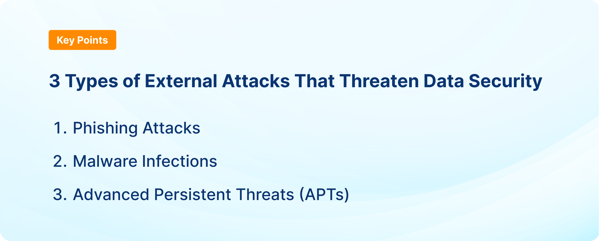
External attacks are an ever-present threat for financial institutions. These attacks, often orchestrated by cybercriminals, aim to exploit system vulnerabilities and gain unauthorized access to sensitive data, including customer information.
While financial institutions invest heavily in advanced security measures, one of the weakest links in the chain of defense can be well-meaning employees who make mistakes. For example, one in four employees report having clicked on a phishing email at work.
Employees can become targets or unwitting accomplices in compromising data security, especially when they lack proper security awareness and training. Here are three of the most common types of attacks — and how data security training can help.
Phishing scammers send fraudulent emails or messages that appear to be from legitimate sources. These communications are an attempt to trick employees into revealing sensitive information, such as login credentials or account numbers. Financial institution employees are attractive targets for phishing attacks because of the valuable data they handle.
By compromising an employee's account or gaining access to their credentials, attackers can infiltrate the financial institution's systems, steal customer data, create fraudulent transactions, and carry out other malicious activities. Phishing attacks can also be used as a steppingstone for more sophisticated attacks, such as spear phishing or targeted malware infections.
Conduct regular training to educate employees about the different types of phishing scams, their characteristics, and the potential risks. Educate employees on how to identify suspicious emails, messages, or websites, including real-life examples. Emphasize the importance of being cautious and verifying the authenticity of requests for sensitive information.
Malware, including viruses, worms, or ransomware, can infect financial systems through various means such as malicious email attachments, compromised websites, or infected software downloads. Successful malware attacks allow bad actors to steal sensitive data, disrupt operations, or hold data hostage for ransom.
Employees in financial services may be targeted through email attachments, infected websites, or malicious downloads. For example, employees might receive legitimate-looking emails that contain attachments with malware, such as ransomware or keyloggers. These attachments can infect the employee's device and spread throughout the organization’s network, compromising sensitive data and systems.
Teach employees to be cautious and skeptical of unsolicited emails, suspicious links, or downloads from untrusted sources. Instruct employees on safe browsing practices, such as avoiding untrusted websites, not clicking on pop-up ads, and only downloading software from official, vetted sources.
Advanced persistent threats (APTs) are sophisticated, targeted attacks that involve a prolonged and stealthy approach. These threats aim to steal sensitive data, conduct espionage, or disrupt financial services. Attackers gain unauthorized access to financial systems and often remain undetected for an extended period.
Financial services employees may be targeted by methods including phishing emails, social engineering, or vulnerabilities in software or systems.
Regularly educate employees about the characteristics of APTs and the tactics attackers use. Train employees to recognize and report suspicious activities, such as phishing attempts or unusual system behavior.
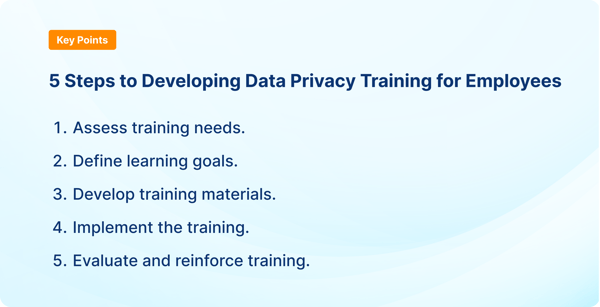
Data privacy training is crucial for employees in financial services. Developing an effective training course requires identifying the most pressing needs and creating engaging training content, among other steps. Here are five steps to get your employees started on their learning journey.
Conduct a thorough assessment of your data privacy requirements, policies, and procedures. Identify specific areas where employees need training, such as data handling, data storage, data sharing, incident response, or regulatory compliance. Review past incidents to better understand weak points in your data training. This review process will help you tailor a specific training program that builds upon past efforts.
Define what you want employees to take away from your training program. These goals should align with your overall data privacy goals and regulatory requirements. Example goals include how to respond to a data breach and how to recognize and report privacy risks.
Additionally, set role-specific learning goals. Bank tellers and loan officers, for example, might have different levels of data access and encounter different day-to-day situations, and your training program should account for those differences. Creating separate learning tracks also supports internal mobility, making it easier for employees to cross-train and move into different roles over time.
Employees at certain levels and roles might need professional certifications to prove that they understand their data privacy duties. The Certified Information Privacy Professional (CIPP) credential, for example, showcases basic knowledge of privacy laws and regulations, including CCPA and GDPR.
Create engaging and informative training materials that effectively communicate the principles and best practices of data privacy. This can include presentations, videos, interactive modules, case studies, and quizzes. Make sure that the materials are easy to understand, relevant to the financial services industry (and to specific roles), and provide practical examples and scenarios.
Trade associations and other industry groups, such as the International Association of Privacy Professionals (IAPP), often provide relevant training and resources.
Determine the most effective training delivery methods, whether that’s in person, through online courses, or both. Consider your workforce's size, geographic distribution, and available resources. Make sure training gives opportunities for employees to ask questions and engage in discussions related to data privacy.
Regularly evaluate the effectiveness of the training program through assessments, surveys, or feedback sessions. Use this feedback to make improvements to training materials and delivery methods.
Additionally, reinforce training by integrating data privacy principles into ongoing employee communications, policies, and procedures. Data privacy training shouldn’t be a one-time activity but rather a part of your organization’s culture and daily practices.
The technology we use to safeguard data privacy is changing every day — and so are the approaches and tactics of hackers and other threats to security. Add a continuing education requirement to help your workforce stay ready to protect data privacy.
Data privacy training for employees in financial services is key to safeguarding sensitive data, but maintaining high standards over time can be challenging.
That's why it's crucial to work with an education verification vendor such as Cisive. Trusted partners can help you verify that employees complete training programs, follow best practices, and comply with regulations — even as the data privacy landscape continues to evolve.
By partnering with a company such as Cisive, you can prioritize data privacy education and build a strong culture of privacy and security within your workforce. Schedule a call with one of our education verification experts to find out how Cisive can help.
Author: Christy Clifton
Bio: Chief Revenue Officer, Cisive. Outside of the office, I spend time outdoors with my husband and two boys. We enjoy mountain biking, boating, snowboarding and hiking as often as we can!
Let's Connect on LinkedIn
Identity theft is on the rise. So, how do you know you’re making an employment offer based on the...

When hiring a new employee for your company, ensuring you’re getting the best candidate is vital....
